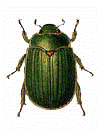Museum, University of Nebraska State
Document Type
Article
Date of this Version
February 1989
Abstract
Baited pitfall traps were used to compare the dung-feeding Scarabaeidae (Coleoptera) of a grazed versus an ungrazed sandhills prairie in western Nebraska. Traps yielded 14,832 coprophagous Scarabaeidae over a 4-week sampling period in 1987. Canthon ebenus (Say), C. pilurarius (L.), Onthophagous hecate Panzer, and O. pennsylvanicus Harold were the dominant species on both prairies. The Shannon-Wiener diversity index indicated that diversity was slightly higher on the grazed site, whereas the Margalef diversity index showed the diversities to be nearly the same. Activity and foraging by scarabs (as measured by trapping success) were found to be most closely correlated with temperature (activity decreasing dramatically about 35 °C) and insulation. Differences in dung beetle abundance and diversity between sampling sites may be due to microclimatological phenomena caused by grazing of cattle.



Comments
Published in 19x9: Transactions of the Nebraska Academy of Sciences XVII: 29-35. Copyright © 1989 Mary Liz Jameson. Used by permission.